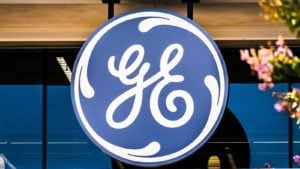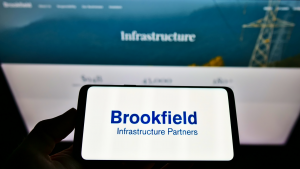Two very powerful forces make infrastructure stocks very attractive at this point. One is the reshoring trend, which refers to American companies building more factories in the U.S. The other is the Bipartisan Infrastructure law, passed in November 2021, but is only starting to have a major impact on companies now. Given the convergence of these two powerful catalysts, this is a great time for long-term investors to find and pull the trigger on the best infrastructure stocks to buy.
Many companies, including computer-chip makers, automakers, battery makers, and firms within the renewable-energy space, are building plants in the U.S. These factories, as CNBC’s Jim Lebenthal has pointed out, will boost infrastructure companies, both while the plants are being built and after they begin manufacturing products.
For example, steelmakers and construction equipment makers will benefit from the building of these plants. At the same time, trucking companies and railroad operators will transport the factories’ finished products after the plants churn out products.
Meanwhile, thanks to the Bipartisan infrastructure law, the federal and state governments are pouring tens of billions of dollars into many types of infrastructure, including electricity, water development, broadband internet, and, of course, highways and bridges.
| Ticker | Company | Price |
| MTW | Manitowoc | $17.44 |
| GE | General Electric | $90.13 |
| VEOEY | Veolia Environment | $28.58 |
| TMUS | T-Mobile | $141.35 |
| MLM | Martin Marietta | $337.55 |
| CSX | CSX | $29.72 |
| BIP | Brookfield Infrastructure Partners | $32.48 |
Manitowoc (MTW)

Source: Shutterstock
Manitowoc (NYSE:MTW), a Wisconsin-based crane maker, delivered blowout fourth-quarter results and appeared to be a “poster child” for the infrastructure boom.
The company’s fourth-quarter revenue surged 25% year-over-year to $621.5 million, coming in $56 million above analysts’ average estimate. Meanwhile, its EBITDA, excluding certain items, soared 50.6% YOY to $51.5 million.
And MTW’s financial results are poised to get even better in the longer term. The company’s CEO, Aaron Ravenscroft, said, “there are plenty of signs that a crane renaissance is on the horizon.” Among the positive catalysts for cranes are strong infrastructure spending in the U.S., China’s reopening, and higher commodity prices, he said.
Further, Saudi Arabia has its own $1 trillion infrastructure spending plan, featuring “4,000 One World Trade centers that stretch 170 kilometers across the desert through the sea and into the mountains,” Ravenscroft noted. Finally, Europe is going to “eventually rebound” from its current slowdown caused by the Russia-Ukraine War, the CEO stated.
Also worth noting is that Manitowoc is well-positioned to benefit from America’s onshoring trend, as thousands of cranes will be needed to build the dozens of factories being developed across America.
General Electric (GE)

Source: Sundry Photography / Shutterstock.com
GE’s (NYSE:GE) electricity-oriented businesses, now known collectively as Vernova, will get a big boost from the Bipartisan Infrastructure Law and the Democrats’ anti-climate change law. Specifically, Vernova’s Grid business will be helped by the $10.5 billion that the Department of Energy plans to spend on enhancing the nation’s electric grid, while the unit’s Renewables business, which features a vibrant wind-turbine manufacturing operation, is going to be lifted by the tax credits for renewable energy that kicks in this year as a result of the anti-climate change law.
In light of these powerful, positive catalysts, I’m hardly surprised that GE recently announced that it expects Vernova’s loss to fall between $200 million to $600 million this year from $1 billion in 2022. Moreover, GE predicts that the unit will be profitable in 2024, while its profit margin will climb to about 5% next year, up from -3.5% in 2022.
Meanwhile, the investors who buy GE stock will also get exposure to the company’s Aerospace unit, which is generating spectacular financial results and is well-positioned to continue growing very rapidly for many years. Specifically, the company expects its commercial jet-engine business to grow at an impressive compound annual growth rate of around 13% between 2022 and 2025. Also noteworthy is that GE expects about 89% of its Aerospace revenue this year to come from providing services for airplanes, up from about 70% last year. That’s significant because servicing airplane engines tend to carry much higher profit margins than selling them.
Despite the recent rally of GE stock, the shares are trading at a low trailing price-operating cash flow ratio of just 16.
Veolia Environment (VEOEY)

Source: sylv1rob1 / Shutterstock.com
With many regions of the globe, including the American Southwest, suffering from terrible droughts, desalination is by far the best and most comprehensive solution. That’s because the world has a virtually unlimited supply of seawater, while there are no other viable ways to obtain massive amounts of freshwater other than desalination.
That’s why many governments, including those of California and Israel, have already embraced desalination on a broad scale, while Arizona is moving forward with its own massive $5.5 billion desalination plant.
Veolia (OTCMKTS:VEOEY) reports that it desalinates water at over 2,300 locations worldwide, making it the world’s largest operator of desalination plants.
In December, America’s Environmental Protection Agency reported, “The Bipartisan Infrastructure Law delivers more than $50 billion to EPA to improve our nation’s drinking water, wastewater, and stormwater infrastructure.”
Given some of the (overdone) concerns about desalination, I’m unsure if any of those funds will be used for desalination or end up in Veolia’s bank accounts. But in any event, Veolia will be a big beneficiary of the coming desalination boom.
Indeed, the company is already posting very strong financial results, as its top line, excluding currency fluctuations, soared nearly 50% in 2022. Excluding currency fluctuations and acquisitions, its sales jumped 16%. Meanwhile, its EBITDA jumped 7.2%, excluding currency changes and acquisitions, to 6.2 billion euros.
T-Mobile (TMUS)

Source: Shutterstock
T-Mobile (NASDAQ:TMUS) has rolled out 5G Home Internet services, leaving it well-positioned to benefit tremendously from the $65 billion allocated by the Infrastructure Law to provide “high speed, reliable” internet access for “every American.”
Additionally, TMUS is taking action on multiple fronts to exploit 5G technology to improve and expand its product portfolio. For example, the telecom company is partnering with Amazon (NASDAQ:AMZN) to provide companies with “customizable, private” 5G internet services. Among the services that T-Mobile will be able to offer companies as a result of the collaboration is “monitoring worker safety on remote industrial campuses, performing predictive maintenance on manufacturing equipment, or ensuring faster aircraft turnaround times at the airport.”
And the company’s widely-used wireless networks are likely to be much easier to deploy and significantly more secure than Wi-Fi systems.
Lastly, T-Mobile is widely recognized as having the nation’s best 5G network, leaving it well-positioned to offer consumers and businesses an array of impressive, highly reliable, very useful 5G services.
Martin Marietta (MLM)

Source: Shutterstock
Martin Marietta (NYSE:MLM) provides raw materials such as “crushed stone, sand, and gravel products,” along with ready-mixed concrete and asphalt to build roads, bridges, and factories. Moreover, MLM provides a type of lime that’s used to make steel.
Given these points, the company is well-positioned to benefit from the huge amounts of money that America’s government is spending on roads, bridges, airports, and railroads. And, of course, MLM will get a big boost from the construction of many new factories in the U.S.
Also noteworthy is that MLM’s exposure to the steel industry leaves it well-positioned to benefit from increased demand for automobiles and planes in the U.S. and many other countries.
“Entering 2023, near-term product demand visibility is supported by healthy customer backlogs driven by an acceleration in public infrastructure investment and announced large-scale energy and domestic manufacturing projects,” MLM CEO Ward Nye said in the company’s fourth-quarter earnings press release.
The company expects its EBITDA, excluding certain items, to climb from $1.8 billion to $1.9 billion in 2023, up from $1.6 billion this year. In 2024, the company expects to benefit from the rejuvenation of the housing market.
CSX (CSX)

Source: Jonathan Weiss / Shutterstock.com
One of the nation’s largest freight-railroad operators, CSX (NASDAQ:CSX), is poised to benefit from increased demand for raw materials due to both the Infrastructure Law and the onshoring trend.
Other possible drivers for CSX stock, according to investment bank Evercore ISI, are increasing demand for automobiles and higher coal prices. Moreover, the bank predicts that the company will benefit from strong demand for all of the offerings it transports, along with improving supply chains.
Lauding CSX as having “the most efficient network service of the major U.S. rails,” the firm predicts that the railroad operator will be able to return a greater amount of capital to the owners of CSX stock going forward.
Evercore has a $33 price target and a “buy” rating on the shares.
For its part, Barclays, a British bank, expects railroad operators to benefit from reduced retail inventories, higher selling prices, “more normal seasonal shipping patterns,” stronger demand, and “easier comparisons” in the second half of the year.
The firm kept an “overweight” rating on CSX.
CSX stock has an undemanding forward price-earnings ratio of 16 times.
Brookfield Infrastructure Partners (BIP)

Source: T. Schneider / Shutterstock
Few other large, very stable companies are as well-positioned to benefit from as many aspects of strong, current trends as Brookfield Infrastructure Partners (NYSE:BIP).
BIP’s Utilities unit manages many systems that generate and transmit electricity, including tens of thousands of miles of “transmission and distribution lines” and “7.3 million electricity and natural gas connections.” The company also owns railroad tracks, natural gas pipelines, and “12,000 kilometers of fiber backbone.”
Among the positive catalysts that could considerably lift BIP in the coming months and years are the electrification of transportation and the Infrastructure Law’s subsidies for internet coverage, railroad improvements, and enhancements of the electric grid.
Also likely to boost BIP’s financial results, by virtue of its exposure to the rail sector, are increasing demand for raw materials as a result of the onshoring trend and higher demand for steel due to increased auto and plane production.
Finally, since BIP also owns “50 data centers and and 2,100 active telecom towers,” it should get a big lift from the Internet of Things and the proliferation of 5G.
In the third quarter of 2022, BIP’s funds from operations climbed 24% year-over-year to $525 million.
BIP stock has a price-sales ratio of 1.1 and a hefty dividend yield of 4.7%.
On the date of publication, Larry Ramer held a long position in GE. The opinions expressed in this article are those of the writer, subject to the InvestorPlace.com Publishing Guidelines.

